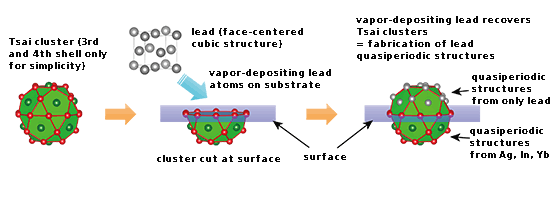Success in Fabrication of Three-dimensional Structure of Single-Element Quasicrystal
Expected to Contribute to Progress in Elucidating Stability of Quasicrystals and Finding New Properties Unique to Quasiperiodic Structure
2013.12.02
(2013.12.24 Update)
Chuo University
National Institute for Materials Science (NIMS)
Tohoku University
A research group consisting of members from Chuo University, NIMS and Tohoku University succeeded for the first time in the world in fabricating a three-dimensional structure of a quasicrystal composed of a single element.
Abstract
A research group led by Assistant Professor Kazuki Nozawa and Professor Yasushi Ishii from the Department of Physics, Faculty of Science and Engineering, Chuo University, Chief Researcher Masahiko Shimoda from the National Institute for Materials Science (NIMS) and Professor An-Pang Tsai from the Institute of Multidisciplinary Research for Advanced Materials (IMRAM), Tohoku University, succeeded for the first time in the world in fabricating a three-dimensional structure of a quasicrystal composed of a single element, through joint research with a group led by Dr. Hem Raj Sharma from the University of Liverpool, the United Kingdom.
Quasicrystals are substances discovered in 1984 by Dr. Dan Shechtman (who was awarded the Nobel Prize in Chemistry in 2011). To date, quasicrystals have been found in more than one hundred kinds of alloy, polymer and nanoparticle systems. However, a quasicrystal composed of a single element has not been found yet. Quasicrystals have a beautiful crystalline structure which is closely related to the golden ratio, called a quasiperiodic structure. This structure is made of a pentagonal or decagonal atomic arrangement that is not found in ordinary periodic crystals (see the reference illustrations). Due to the complexity of the crystalline structure and chemical composition, much about quasicrystals is still veiled in mystery, including the mechanism for stabilizing a quasiperiodic structure and the novel properties of this unique type of crystalline structure. For these reasons, efforts have been made for a long time in the quest for a chemically simple type of quasicrystal composed only of a single element. The joint research group has recently succeeded in growing a crystal of lead with a quasiperiodic structure which is modeled on the structure of a substrate quasicrystal, by vapor-depositing lead atoms on the quasicrystal substrate of an existing alloy made of silver (Ag), indium (In) and ytterbium (Yb). Success using this approach had been reported for fabricating a single-element quasiperiodic film consisting of a single atomic layer (two-dimensional structure), but there had been no successful case of fabricating a single-element quasiperiodic structure consisting of multiple atomic layers (three-dimensional structure). This recent success by the joint research group is a significant step forward toward achieving single-element quasicrystals. It is also expected to lead to advancement in various fields, such as finding properties unique to quasiperiodic structures that cannot be found in periodic crystals and elucidating the mechanism of stabilization of quasiperiodic structures.

Figure 2: Illustrations of the deposition structure of lead. The Tsai cluster in the substrate quasicrystal which is near the surface of the substrate is cut at the point where it contacts the surface. While lead usually has a face-centered cubic structure, it is deposited on the quasicrystal substrate in a manner that it recovers Tsai clusters which are cut near the surface of the substrate. This indicates that a crystal of lead is grown with the same structure as the structure of the quasicrystal substrate.
